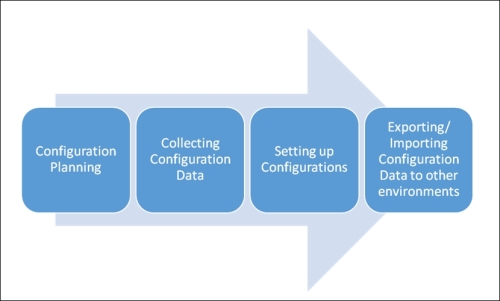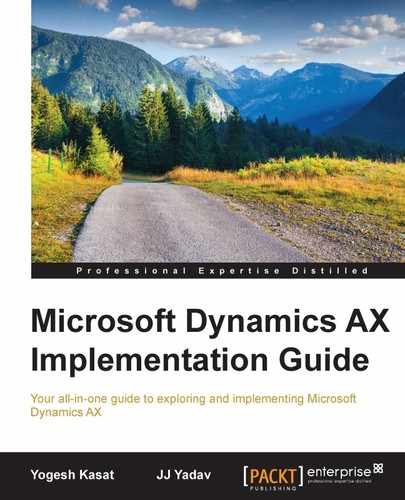In this chapter, we will learn about configuration planning, collecting configuration data, the tools available to facilitate configuration, and the various approaches towards configuration management and promoting configurations from one environment to another.
The configuration of an ERP system is one of the most important parts of the process. Configuration means setting up the base data and parameters to enable your product features such as financial, shipping, sales tax, and so on.
Dynamics AX has been developed based on the generic requirements of various organizations and contains the business processes belonging to diverse business segments. It is a very configurable product that allows the implementation team to configure features based on specific business needs. During the project, the implementation team identifies the relevant components of the system and sets up and aligns these components to meet the specific business requirements. This process starts in the analysis phase of the project carrying on through the design, development, and deployment phases.
Configuration management is different from data migration. Data migration broadly covers the transactional data of the legacy system and core master data, such as opening balances, Open AR, Open AP, customers, vendors, and so on. When we talk about configuration management, we are referring to items like general ledger, fiscal years and periods, chart of accounts, segments, and defining applicable rules, journal types, customer groups, terms of payments, module-based parameters, workflows, number sequences, and the like. In a broader sense, configuration covers the basic parameters, master data, and reference data that you configure for the different modules in Dynamics AX.
The following diagram shows the different phases of configuration management:

Configuration planning is, basically, identifying all the configurations required for your implementation project. Most configuration requirements are known from the solution design phase and finalized with the sign-off of the functional and technical design specifications.
The first step towards configuration planning is to identify the modules and functional areas which need be to be configured. The following are some pointers for getting started with the planning:
- Create a list of configurations that are needed for the project, and identify and assign the resources responsible for configuration. As a part of this list, identify the cross-functional module configuration and add secondary responsible resources. Microsoft Sure Step provides a fairly comprehensive list of parameters and configuration data, based on the module and functional role, in the Data Migration Requirements checklist spreadsheet. You can use this spreadsheet as a starting point to identify all the configurations and add the column for the resources responsible for them.
- Build a list of environment-specific configurations. Some of the configurations, such as links between applications talking to each other, need to have different values in different environments. For example, you need to ensure that the test instance of Dynamics AX is pointing to the test instance of the shipping solutions and that the payment gateways are configured in the test mode.
- Identifying such lists early on helps in reviewing these configurations specifically in every environment, prior to, and after, going live (especially with data restores).
- Ideally, you should automate the changes to such configurations while moving the data across environments to avoid the risk of human errors.
- The following table represents a sample list of environment-specific configurations:
Configuration
Environment
Value
Web service URL for sales tax software
Development
http://DEV.TAXServices.svcTesting
http://TEST.TAXServices.svcProduction
https://Prod.TAXServices.svcPayment gateway setting
Development
http://DEV.Paymentgateway.aspxTesting
http://DEV.Paymentgateway.aspxProduction
https://Prod.Paymentgateway.aspxFile-share path (document management)
Development
\DEVBATCHAOS001DocumentShareTesting
\TESTBATCHAOS001DocumentShareProduction
\PRODDocumentShare001DocumentShare
- Maintain a list of company-specific configurations. When you are planning global roll outs, define a global template and maintain a list of configurations that needs to be revisited for every company.
- As far as possible, you should try and keep the same reference tables (for example, same codes for customer groups). Of course, different companies may require different parameters or configurations to meet specific country or business unit requirements, but those should be specifically evaluated to ensure that these differences do not hamper intercompany transactions or future consolidation efforts.
- There may be customizations that are company-specific which you may want to turn on or off in case of the other companies. Keep track of such parameters in your configurations list while you are building the functional/technical designs.
- The number sequences and base currencies may be different.
- Specific GL accounts would have to be added/suspended in a specific company.
- Maintain a list of batch jobs. Periodic processes can be scheduled using batch jobs in Dynamics AX. Even though scheduling a batch job is also a kind of configuration, you should have a list of all the batch jobs that you plan to have, along with their frequencies, parameters, and so on. Maintain a separate list of batch jobs to configured in each environment. The following table represents a sample list of batch jobs:
Columns
Description
Example 1
Example 2
Batch job name
Name of the batch job
Auto-invoicing domestic orders
Product creation batch
Functional area
AP, AR, Inventory, and so on.
AR
Product information management
Business owner
Who, from business, should be contacted for testing, errors (If batch job fails, once you go to Production)
AR manager
PIM manager
Consulting owner
Person responsible from the consulting team
Yogesh Kasat
JJ Yadav
IT owner
Person responsible from the internal IT team
Finance BSA
PIM BSA
Frequency
How often does the batch job need to run (for example, every 15 minutes, every day at 6 P.M.)
Every 15 minutes; from 6 a.m. through 7 p.m. (timings are driven by batch group and active AOS as batch)
Everyday at 6 p.m
Parameters
Any filters or parameters to be defined while scheduling the batch job
Sales origin = 'Domestic'
Record status = "Ready"
Dependencies
Scheduling dependencies between batch jobs
Path or class name
Path from where to access the menu or class to be used for scheduling the batch job
ARperiodicupdateinvoice
PIMperiodic832 item creation (custom)
Batch group
DayTime*
NightTime
Comments
Additional comments
*The DayTime batch group has AOS defined as a batch AOS only during business hours (6 a.m. through 7 p.m.).
